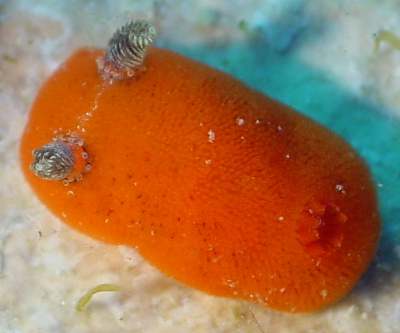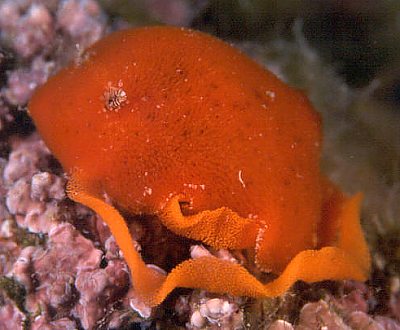

Rostanga rubra
(Risso, 1818)
Order: NUDIBRANCHIA
Suborder: DORIDINA
Superfamily: EUDORIDOIDEA
Family: Dorididae
DISTRIBUTION
Recorded from the Atlantic coast of Europe and North Africa, and from the Mediterranean.
PHOTO
Upper: Cerbere, France, Mediterranean coast, July 11, 2003. Size: 8-10mm. Photo: Marina Poddubetskaia
Lower: 15/05/2002
Place: Kemer, Turkey, 15 May 2002, Depth: 15m, Size: 6-7cm. Photo: Levent Konuk
Thompson & Brown, (1984) and Schmekel & Portmann (1982) considered Rostanga coccinea and R. perspicillata to be synonymous with R. rubra (Risso), and R. rufescens to be an unnecessary replacement name for R. coccinea. Not mentioned in these reviews is R. temarana Pruvot-Fol, 1953, described from the Atlantic coast of Morocco which shows no difference in radular morphology from R. rubra and at 3-4 mm long, is almost certainly based on juveniles.
Rostanga rubra is red with vertically arranged rhinophore lamellae. The bifid outer lateral teeth are similar to those of the Indo-West Pacific species R. bifurcata, from which it differs in rhinophore shape and shape of inner lateral teeth. The inner lateral teeth of R. rubra have been described as bicuspid by many authors because of a prominent pointed projection on the outside of the main cusp. This secondary 'cusp' is derived from the angular shoulder present on the inner lateral teeth of many species of Rostanga.
The egg-ribbon has been described as white (Alder & Hancock, 1848) and 'rose-coloured' (Kress, 1971). Kress has carefully observed and measured all stages in development from single-celled egg to hatching Type 1, planktotrophic veliger in 12 days (15-18°C). The egg ribbon of almost two whorls is a stiff jelly-like structure similar to that of Rostanga arbutus but the eggs are much smaller.
Because of the well-known problems concerning sponge taxonomy and misidentifications, food records for this species must be treated with some caution. Kress (1971) records it from Microciona atrosanguinea and rarely from Hymeniacidon sanguinea while Thompson & Brown (1984) state that it "feeds upon red siliceous sponges such as Microciona sanguinea Bowerbank". Brown & Picton (1979) note that it "feeds on sponges (e.g. Ophlitaspongia seriata)".
References:
• Rudman, W.B. & Avern, G.J. (1989) The genus Rostanga Bergh, 1879 (Nudibranchia:
Dorididae) in the Indo-West Pacific. Zoological Journal of the Linnean Society, 96: 281-338.
• Schmekel, R. L., & Portmann, A. (1982) Opisthobranchia des Mittelmeeres, Nudibranchia und Saccoglossa. Fauna e flora del Golfo di Napoli 40, Monografia della Stazione Zoologica di Napoli, pp. i-viii, 1-410, pls. 1-36. Springer-Verlag.
• Thompson, T. E. & Brown, G.H. (1984) Biology of opisthobranch molluscs, vol. 2, 229 pp., 41 pls. Ray Society, no. 156.
Rudman, W.B., 2002 (February 17) Rostanga rubra (Risso, 1818). [In] Sea Slug Forum. Australian Museum, Sydney. Available from http://www.seaslugforum.net/factsheet/rostrubr
Related messages
-
Rostanga rubra from Turkey
From: Hakan Kabasakal, June 2, 2010 -
Rostanga rubra from Devon, UK
From: Judith Oakley, August 13, 2005 -
Rostanga rubra from Slovenia
From: Tom Turk, June 13, 2005 -
Rostanga rubra from Scotland
From: Jim Anderson, August 6, 2004 -
Rostanga rubra - eggs ?
From: Jean-Pierre Bielecki , July 28, 2003 -
Rostanga rubra from French Mediterranean
From: Marina Poddubetskaia, July 21, 2003 -
Rostanga sp. from Turkey
From: Baki Yokes, May 27, 2002 -
Rostanga rubra from Mediterranean
From: Erwin Koehler, February 19, 2002 -
Rostanga rubra from W-France
From: Erwin Koehler, February 19, 2002
